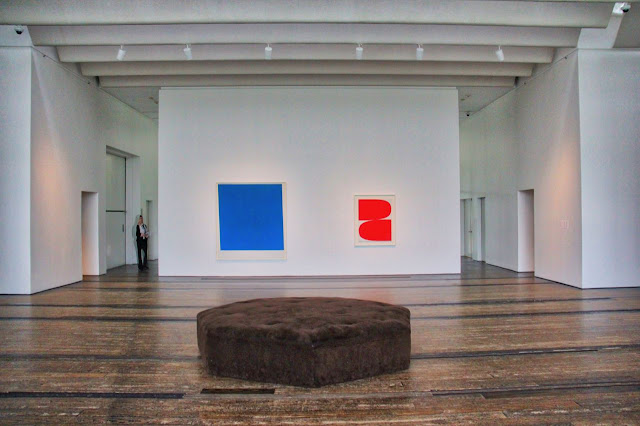Houston is a town with no memory. If you stand still, Houston will trample you. Houston leans forward.
Our governor recently came under local (to Austin) criticism for pushing bills to restrict zoning and stop the protection of trees statewide. Unfortunately for Austin, he built a house here and had to live through the nightmare of the city's various zoning requirements (we consider them deisgn challenges). People forget that the guv came from Houston. Houston don't care 'bout no damn trees, height restrictions, FAR ratios, etc., etc. I'm sure the governor was, like: "What is this sh!t?"
Ironically (for both sides of the issue), less restrictive zoning is more progressive. Higher uses of property lead to more affordable rents and mortgages and larger tax bases. Restrictive zoning keeps the ruling class in rule and keeps "poor people" out (poor people in quotes because in-town living even keeps the middle-class riffraff away). Our neighborhood is a special kind of elitist (however unintentional) in that it even wants to prevent mixed-use development on the neighborhood's edges. Sad!
renzo piano
Speaking of putting an art museum in the middle of a neighborhood, that's exactly what the Menils, heirs to the Schlumberger fortune, did when they sought a home for their 17,000 art objects. The Menils chose a neighborhood of bungalows in Montrose to build their museum. Given their support of early Modernism in painting and sculpture, it's not a surprise that they reached out to Modernism for their museum. They first spoke to Louis Khan about designing a space, but he (and Mr. Menil) passed away before realizing a design. Mrs. Menil then reached out to Renzo Piano for what would become Piano's first design for the United States.
Renzo, along with Richard Rogers, had recently finished the look-at-me Pompadou in Paris, so the subdued design for the Menil was a shock (and the start of Piano's respectful museum designs; atonement for the Pomp and circumstance in Paris?). Responding to the bungalows, Piano strayed no higher than two stories, provided a healthy setback, and used bungalow-inspired lapboard cladding. The design is Modern but highly respectful of its environment. It's the wallflower sister to the drag queen in Paris.
A bungalow in the hood.
Wall detail of the Menil. Note the clapboard, mellow colors, and expressed structure.
Piano also carried the interior ceiling structure for indirect light outside of the building.
Ceiling structure inside.
Ceiling structure inside.
Front door.
Piano also designed the Cy Twombly Gallery, part of the Menil campus.
mark rothko (with a dash of philip johnson)
The Menils commissioned Rothko, the brilliant minimalist painter, to create a place to meditate with site-specific paintings. Rothko sequentially, and vocanicaly, worked with a number of architects, including Philip Johnson, on the space. The chapel--dark and contemplative--is Rothko's architectural suicide note: He killed himself before the building was finished but not before he completed his heavy, foreboding paintings. Sadly, no photos allowed inside...
photo from here
dan flavin
An old Art Deco retail building on the Menil campus holds a few installations by Dan Flavin.
francois de menil
The son of Mrs. Menil, Francois de Menil, designed the Byzantine Fresco Chapel, a delightful fusion of sculptural Brutalism and rustic touchstones.
Misc. sites in the area:
The cafe at the Menil.
That's right. In Houston, you can call someone to come clean your grill.
New construction on the campus. We saw these architects talk about this project in Marfa a couple years ago.
philip johnson
A bit down the street from the Menil is Philip Johnson's Chapel of St. Basil and the academic mall for the University of St. Thomas. The academic mall represents Johnson's mancrush on Mies van der Rohe's IIT campus, but more integrated. At the end of the formalistic academic buildings is the Post Modern chapel, all tied together with covered walkways. It's a fantastic example of architectural symbolism: the formalism representing the controlled rigor of collegiate learning anchored by the flowing etherealism of faith pierced by determinism.
A building under construction down the street, clearly inspired by the chapel.
mies van der rohe
This is the only Mies-designed museum in the United States, built in two stages in 1958 and 1974.
Master plan for the museum district.
Didn't realize that Diego Rivera started off as a cubist painter!
"La casa blanca" by Jose Clemente Orozco
Reproduction of an amazing anti-fascist mural by David Alfaro Siqueros.
Painting by Juan O'Gorman, an early Modernist architect in Mexico (who designed Rivera and Kahlo's bridge houses).
Frida Kahlo
One my fave Kahlo's
Portrait of Diego Rivera
A favorite Georgia O'Keefe
Elsworth Kelly's "Houston Triptych"
san jacinto monument
The last battle for Texas independance, where Houston's army defeated Santa Anna's, is marked by an imposing Aert Deco tower designed by Alfred C. Finn.
Gorgeous! Inspires me to restore ours and install them in our house...
misc.
VRBO we stayed at. Love that window!
Convention center
This place was fantastic!
bajillions of mole
We chose the dessert with candied ants. "Does that say ants?"
The ants were HUGE!!!
bbq at The Pit Room. Fantastic.







































































































No comments:
Post a Comment